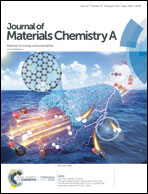Amino-functionalised conjugated porous polymers for improved photocatalytic hydrogen evolution†
Abstract
Two novel truxene-based conjugated porous polymers (CPPs), Tr-F8 and Tr-F3N with octyl and amino side chains, were designed for photocatalytic hydrogen evolution. The introduction of hydrophilic amino side chains significantly improved the wettability of Tr-F3N, resulting in a largely enhanced hydrogen evolution rate (HER) in comparison with that of hydrophobic octyl functionalised Tr-F8. Density functional theory simulation indicates that the amino groups can enhance the interaction between H2O molecules and photocatalysts at a molecular level, resulting in more efficient charge transfer. As a result, a high HER over 500 μmol h−1 g−1 was achieved for Tr-F3N with triethanolamine as the sacrificial electron donor in the absence of co-catalysts. Moreover, a positive correlation between the wettability and HER of CPPs was obtained through structural evolution of CPPs by increasing their amino group density. Our work formulates a novel design guideline for organic photocatalysts for hydrogen evolution, which can be used as a universal strategy to improve the photocatalytic activity of organic photocatalysts.



 Please wait while we load your content...
Please wait while we load your content...